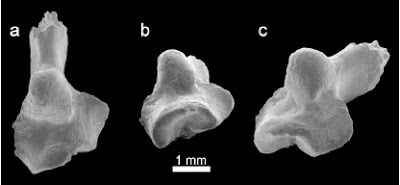Modern Antarctica lacks any permanent Mammal fauna, being visited by
only a few marine Mammals for breeding purposes. However this has not always
been the case. During the Eocene the last parts of the ancient continent of
Gondwana were still breaking apart, and the Antarctic Peninsula was still
attached to South America. This area appears to have had a far more agreeable
climate than it does now, and a variety of Mammal fossils have been found here,
all showing close affinities to those found in South America.
In a paper published in the journal Palaeontology on 16 July 2014, a team
of scientists led by Javier Gelfo of the División Paleontología de Vertebrados
at the Museo de La Plata, CONICET (the National Scientific and Technical Research Council of Argentina) and the Cátedra Paleontología Vertebrados
at the Facultad de Ciencias Naturales y Museo at the Universidad Nacional de LaPlata describe two isolated Mammalian fossils from a shell bed at the base of
the Acantilados II Allomember of La Meseta Formation on Seymour Island, off the
east coast of the Antarctic Peninsula. This formation is thought to be bed is
thought to be 55.3 million years old, making it Earliest Eocene, and the oldest
site to have yielded fossil Mammal remains on Antarctica.
Geographical and stratigraphical provenance of the
Seymour Island Mammals. Gelfo et al. (2014).
The first specimen described is a fragment of tooth which Gelfo et al. ascribe to an unknown Sparnotheriodont Liptotern.
The Liptoterns were a group of herbivorous Placental Mammals indigenous to
South America, which appeared in the Palaeocene and persisted until the closure
of the Panama Seaway, when they rapidly went extinct, apparently unable to cope
with competition from invading Horses, Tapirs and Deer and predation by
invading Placental Carnivores. The Sparnotheriodonts were medium to
large members of this group, which are known from the Palaeocene and Eocene of
Brazil, Mendoza Province in Argentina, Patagonia and Antarctica.
Gelfo et al. note that the tooth very
closely resembles that of Notiolofos arquinotiensis,
although this species is recorded only from a single specimen on James Ross
Island, dated to 37.8 million years old, making a 17.5 million year gap between
the two specimens; an improbable period of time for a Mammal species to
persist. They suggest instead that the tooth may have come from a closely
related species, potentially in the same genus.
Notiolofos cf. Notiolofos arquinotiensis.
Occlusal view of the talonid fragment of the lower right molar,
andreconstruction of the complete tooth based on the Ross Island Specimen adjusted
to fit with the fragmentary specimen. Scale bar represents10 mm. Abbreviations:
c, crest; co, cristidobliqua; ect, ectoflexid; hyp, hypoconid; hyptid, hypocristid;
me, metaconid; tb, talonid basin. Top and left of the figure, mesial and
lingual side, respectively. Gelfo et al. (2014).
The second specimen described is a phalanx from an
unknown Mammal. This is well preserved and 20.45 mm wide (quite big). While it
is not generally thought possible to identify Mammal species from isolated
phalanxes, Gelfo et al. suggest that
this is most likely from a large Placental Mammal with South American
affinities such as a Xenarthran or Liptotern; while Marsupial Mammals are more
common than Placentals in Antarctic faunal assemblages, the largest phalanx
recorded from an Antarctic Marsupial is only 5.58 mm wide, making it unlikely
that this bone had a Marsupial origin.
The Seymour Island Phalanx, in (A) plantar; (B)
dorsal; (C) distal; (D) proximal views. Scale bar represents 10 mm.
Abbreviations. app, articular surfaces for proximal phalanges; con, condyle;
pe, Processusextensorius; pf, proximal foramina; pp, plantal projections. Gelfo et al. (2014).
See also…
South America was effectively an island continent for much of the
Cenozoic, connected only to Antarctica in the south. As such it was not
colonised by carnivorous Placental Mammals until the closure of the
Panama...
 A 'South American' Marsupial from the early Eocene of Australia. Modern Australian Marsupials are generally held to be a distinct
evolutionary lineage, distinct from South...
A 'South American' Marsupial from the early Eocene of Australia. Modern Australian Marsupials are generally held to be a distinct
evolutionary lineage, distinct from South...
 New Caviomorph Rodents from the Early Oligocene Tinguiririca Fauna of the Andean Main Range of central Chile All South American Rodents are classified as members of a single
monophyletic group, the Caviomorpha. This appears to be most closely
related to Rodents with African and...
New Caviomorph Rodents from the Early Oligocene Tinguiririca Fauna of the Andean Main Range of central Chile All South American Rodents are classified as members of a single
monophyletic group, the Caviomorpha. This appears to be most closely
related to Rodents with African and...
 A 'South American' Marsupial from the early Eocene of Australia. Modern Australian Marsupials are generally held to be a distinct
evolutionary lineage, distinct from South...
A 'South American' Marsupial from the early Eocene of Australia. Modern Australian Marsupials are generally held to be a distinct
evolutionary lineage, distinct from South... New Caviomorph Rodents from the Early Oligocene Tinguiririca Fauna of the Andean Main Range of central Chile All South American Rodents are classified as members of a single
monophyletic group, the Caviomorpha. This appears to be most closely
related to Rodents with African and...
New Caviomorph Rodents from the Early Oligocene Tinguiririca Fauna of the Andean Main Range of central Chile All South American Rodents are classified as members of a single
monophyletic group, the Caviomorpha. This appears to be most closely
related to Rodents with African and...
Follow Sciency Thoughts on Facebook.




